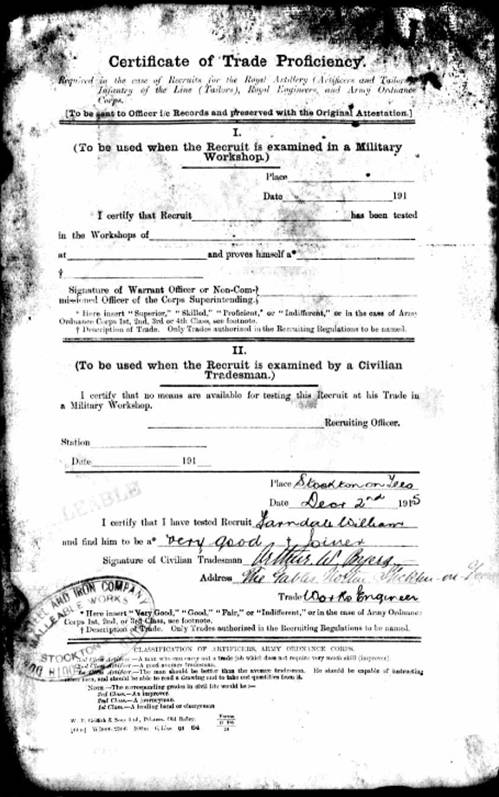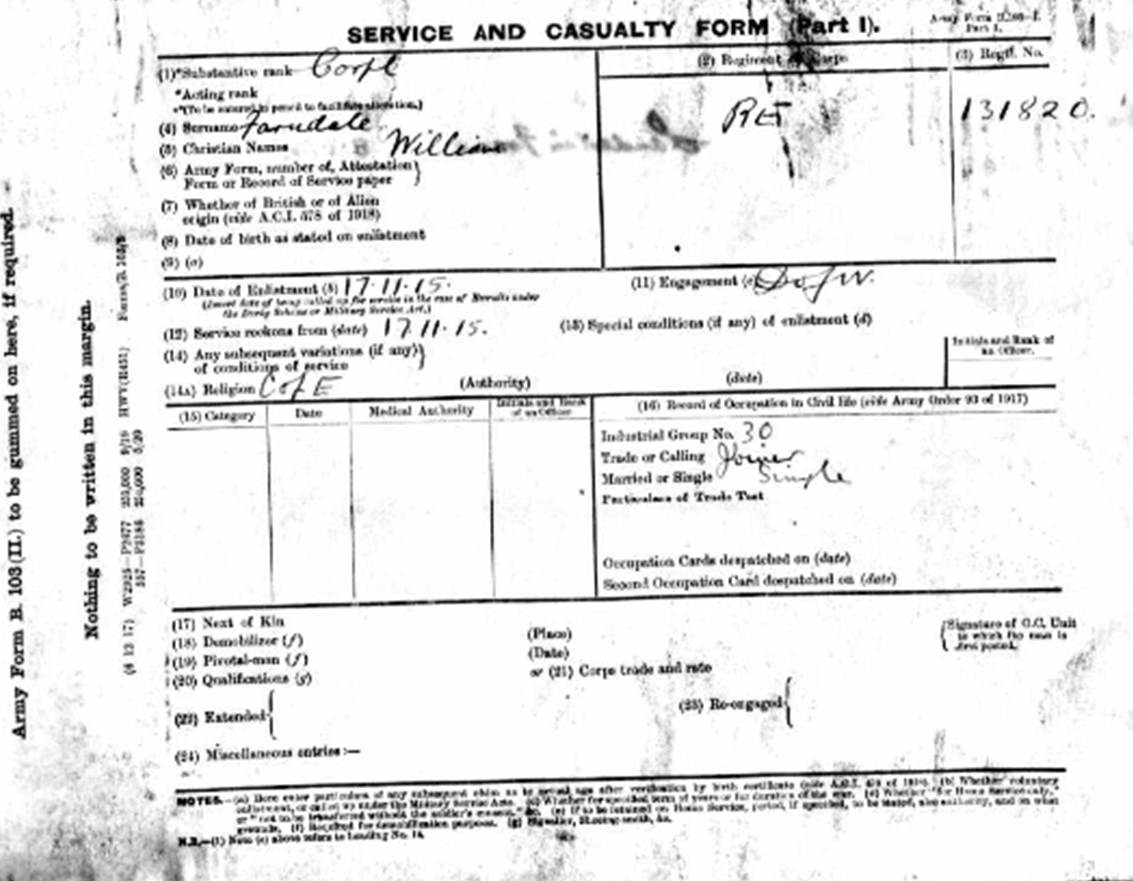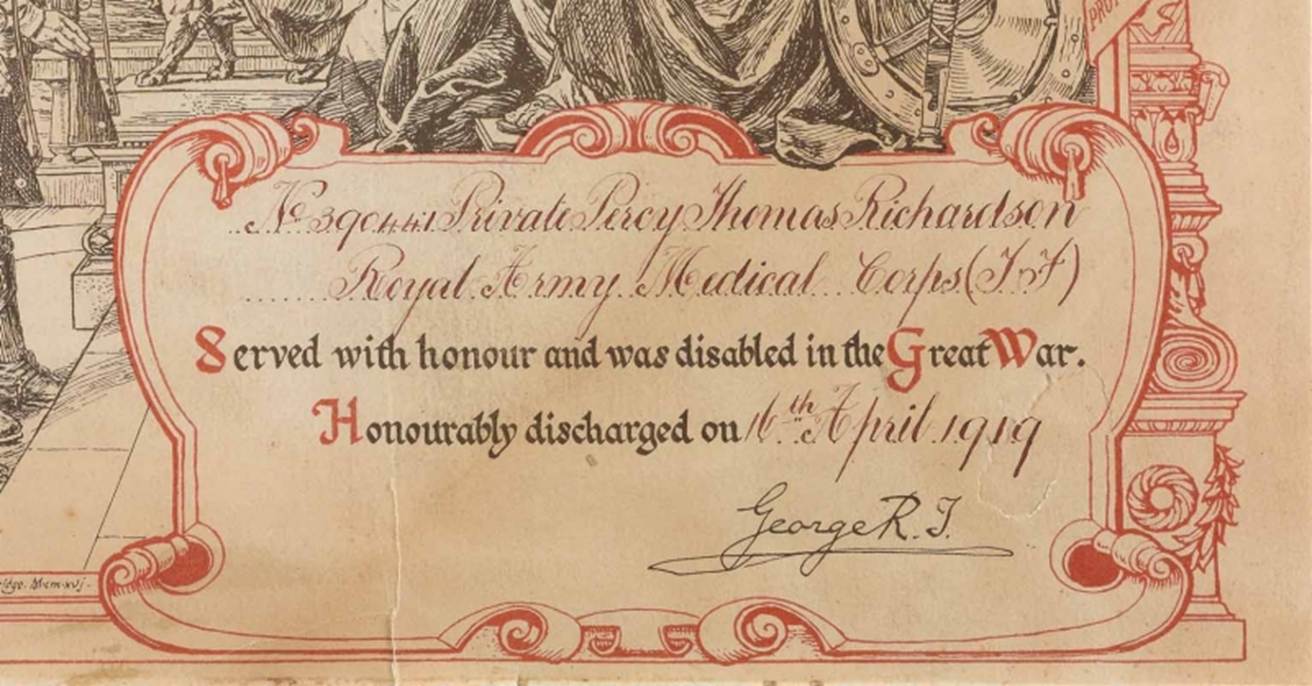William Farndale
22 January 1890 to 1976
FAR00639
|
Return to the Home
Page of the Farndale Family Website |
The story of one
family’s journey through two thousand years of British History |
The 83 family lines
into which the family is divided. Meet the whole family and how the wider
family is related |
Members of the
historical family ordered by date of birth |
Links to other pages
with historical research and related material |
The story of the
Bakers of Highfields, the Chapmans, and other related families |
Dates are in red.
Hyperlinks to
other pages are in dark
blue.
Headlines of
William’s life are in brown.
References and
citations are in turquoise.
Context and local
history are in purple.
Geographical
context is in green.
Great Ayton
1890
William
Farndale, son of William (Master Joiner of Great Ayton) and Mary (nee
Jackson) Farndale (FAR00309)
was born at Great Ayton on 22 January
1890 and baptised on 14 February 1890 (Birth Certificate, Great Ayton
PR). His birth was registered on 4 March 1890 at Stokesley District
by William Farndale, father (GRO Vol 9d page 606).


1891
Census
1891 –
Great Ayton
William Farndale,
59, joiner
Mary Farndale, 59
Mary Farndale, 12,
scholar
John J Farndale,
9, scholar
William Farndale, 1

1901
Census
1901 –
High Street, Great Ayton
William Farndale,
head; married; age 69; joiner, born Gt Ayton, (ie born 1832).
Mary Farndale, wife (2nd); married; age 49; born
Great Ayton (ie born 1852).
Mary Farndale, daughter; age 22, born Great Ayton
(ie born 1879) (FAR00558).
John Joseph
Farndale, 19, son, joiner (FAR00581).
William Farndale,
11, (born 1890) (FAR00639).

1911
Census
1911 –
Hazel House, Great Ayton (5 rooms)
William Farndale, head; married; age 80; retired joiner and builder, born Gt
Ayton, (ie born 1832).
Mary Farndale, wife (2nd); married; age 59; born
Great Ayton (ie born 1852).
John Joseph Farndale (FAR00581), 29, son,
joiner (house).
William Farndale
(FAR00639), 21, (born
1890), joiner (house).

1915
Military Record
131820 William
Farndale, 25, from Great Ayton,
served in 235th Army Troops Company, Royal Engineers. His religion
was Church of England and his next of kin was his mother, Mary Farndale.
His Medical
History Form shows he was a joiner, 5 feet and 10 inches tall, in good
physical development. His attestation shows he lived at Hazel House, Great
Ayton and was a joiner and carpenter.
His active
service record shows that he enlisted on 17 November 1915.
































1917
He was promoted
to Lance Corporal on 4 March 1917. He was a carpenter by trade. A record on 3
February 1917 shows his skill as a carpenter and joiner were superior.
His service
record shows that he was in England from 17 November 1915 to 8 March 1916;
with the BEF in France from 9 March 1916 to 28 July 1917, and then in England
from 29 July 1917 to 19 September 1918.
A further Active
Service Form shows that he was promoted to Corporal in March 1917 and was
wounded in a gas attack in April 1917 when he was transferred to England to 2
General Hospital.
He achieved the
rank of Lance Corporal, Royal Engineers Class ‘P’ AR. He enlisted on 17
November 1915 and was discharged on 30 December 1918. The cause of discharge
was Para 392 (xvia)(Gas psng).
His Medical
report shows that he was gassed with a disability originating on 12 July
1917, but he appears to have been ‘released for coal mining’. However a
Memorandum from the Eastern Command Discharge Centre to Chatham on 1 June 1918
said “This NCO having been placed in Grade II (which is equivalent to
Military Category Bi) by the Civilian Medical Board at this Centre, he is not
now eligible for transfer to the Army Reserve as a Coal Miner. AFW 3980 has
accordingly been returned to the War Office.” Another Medical
report confirms he was gassed in
1917. A continuation
shows he suffered 20% disability. Consequently, he received a pension
for his gas disability. His symptoms were described in another form.
He was ‘less
than 20%’ disabled by the gas attack. His pension was renewed.
This was also confirmed in an Award
Sheet. Another document shows a weekly pension of 6 shillings from 20
September 1918 to be reviewed in 52 weeks. See also the Renewal
Sheet.
He achieved the
Rank of Corporal.
1918
On 10 January
1918 he overstayed his pass for 22 hours, but was admonished.
A record
addressed to the Eastern Command Discharge Centre at Sutton in Surrey on 16
September 1918 said “Owing to the Medical Authorities being extremely busy,
this NCO could not be Boarded until this day, and he has been directed to
report to you on the 17th instant.” Another record on that date at
Chatham certified William as free from contagious disease and fit to travel by
train.
He was transferred
to the reserve on 21 September 1918.
Medals and
decorations: Victory Medal, British Medal.
1919
Silver Badge Roll
11 November 1919.
The
Silver War Badge was awarded to most servicemen and women who were discharged
from military service during the First World War, whether or not they had
served overseas. Expiry of a normal term of engagement did not count and the
most common reason for award of the badge was King’s Regulations Paragraph 392
(xvi), meaning they had been released on account of being permanently
physically unfit. This was as often a result of sickness, disease or uncovered
physical weakness and war wounds. Soldiers discharged during the war because of
disabilities they sustained after they had served overseas in a theatre of
operations (an area where there was active fighting) could also receive a
King’s Certificate. Entitlement to the Silver War Badge did not necessarily entitle
a man to the award of a King’s Certificate, but those awarded a Certificate
would have been entitled to the Badge.
392
(xvi) No longer physically fit for was service – (a) During a period of war or
demobilisation – (i) If the soldier is a patient in hospital; (ii) if the
soldier is not a patient in hospital. A soldier found medically unfit for
further service by an authorised Medical Board, irrespective of his length of
service, ie unfit for any medical category required in the army, will be
discharged under this heading. A soldier found medically unfit to re-engage,
any soldier discharged for insanity, irrespective of his length of service,
will be dealt with under this heading....
The
main purpose of the badge was to prevent men not in uniform and without
apparent disability being thought of as shirkers – it was evidence of having
presented for military service, if not necessarily serving for long.

An
example
1921
1921
Census – High Street, Great Ayton
Mary
Farndale, head, born 1851 at Great Ayton, Home Duties
William
Farndale, son, born 1890 in Great Ayton, 31, a joiner with Lees Furnall Co,
Rosebury Mines, but out of work

1923
William
Farndale, married Florence Mary Whitworth on 22 November 1923 (Great
Ayton PR).

Florence
Mary Whitworth was the daughter of Ralph Holmes Storey (1858 to 1906) and
Thomasine Ann Pickering (1858 to 1938) and was born in about 1885. She had
previously married Herbert France Whitworth in 1907, but was a widow and a manageress
in Stokesley by 1921 (1921 census). She had a daughter, Florence
Mary Whitworth.
1939
1939
Census – Buck Hotel, Levenside, Great
Ayton
William
Farndale, born 22 January 1890, licensed victualler, married
Florence
M Farndale, born 15 January 1885, his wife
Three
others

1945
Presumably
Florence Whitworth’s only daughter by a previous marriage (she must have been a
widow of the late R Whitworth):
Newcastle
Journal, 27 September 1945: GOSFORTH MAJOR WEDS. Rev R Bradshaw officiated at
the wedding at the parish church, Great Ayton, near Middlesbrough, yesterday,
of Major Hartley C Makepeace RASC, youngest son of Mrs and the late Mr J B
Makepeace, of Gosforth, and Miss Florence Mary Whitworth, only
daughter of Mrs Farndale, and the late Mr Whitworth, of the Buck Hotel,
Great Ayton. The bride was given away by her brother, Mr Ralph W Whitworth, and
Captain J R Boston, RASC, was the best man.
1976
William Farndale, aged 86, died in 1976 and his
death was registered in the fourth quarter of 1976 in Northallerton (GRO
Vol 2 page 2313).
1977
Florence
Mary Farndale died in Middlesbrough on 9 February 19977 (Probate
Index).




